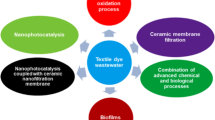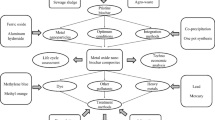Abstract
Heavy metal pollution has become a serious problem for living organisms. In this study, silk fibroin (SF)/nylon-6 nanofiber matrices were formed by electrospinning and their surface was modified with calcium phosphate (CaP) crystals to increase the affinity of divalent heavy metals. The properties of matrices were evaluated as a filter matrix for copper adsorption from aqueous solution. Attenuated total reflectance fourier transform infrared spectroscopy (ATR-FTIR), scanning electron microscopy (SEM), energy-dispersive X-ray spectroscopy (EDXS), X-ray photoelectron spectroscopy (XPS), and alizarin red staining method were used for characterization. Adsorption studies were performed by batch and continuous system. The various parameters regarding adsorption process such as pH of solution, surface area, initial copper concentration, and flow rate were optimized. Toxicity values were assessed before and after the Cu(II) adsorption studies. The resultant SF/nylon-6 nanofiber matrices indicate an excellent fibrous structure without beads (fiber diameter at 250 ± 50 nm) and modified successfully with CaP crystals. Adsorption results showed that the removal efficiency of copper could reach 32 % by continuous flow system whereas 77 % by batch system. Acute toxicity bioassays using Vibrio fischeri showed that the toxicity decreased after continuous and batch flow systems. For desorption study, different concentrations of various desorption solutions were used and the percentage of Cu(II) desorption was determined as 11 %, approximately.











Similar content being viewed by others
References
Al-Gheethi AAS, Norli I, Lalung J, Azlan AM, Farehah ZAN, Kadir MOA (2014) Biosorption of heavy metals and cephalexin from secondary effluents by tolerant bacteria. Clean Technol Environ Policy 16(1):137–148
Arai T, Freddi G, Innocenti R, Tsukada M (2004) Biodegradation of Bombyx mori silk fibroin fibers and films. J Appl Polym Sci 91:2383–2390
Ayutsede J, Gandhi M, Sukigara S, Micklus M, Chen HE, Ko F (2005) Regeneration of Bombyx mori silk by electrospinning. Part 3: characterization of electrospun nonwoven mat. Polymer 46(5):1625–1634
Baek DH, Ki CS, Um IC, Park YH (2007) Metal ion adsorbability of electrospun wool keratose/silk fibroin blend nanofiber mats. Fiber Polym 8(3):271–277
Bilal M, Shah JA, Ashfaq T, Gardazi SMH, Tahir AA, Pervez A, Haroon H, Mahmood Q (2013) Waste biomass adsorbents for copper removal from industrial wastewater—a review. J Hazard Mater 263:322–333
Buchko CJ, Chen LC, Shen Y, Martin DC (1999) Processing and microstructural characterization of porous biocompatible protein polymer thin films. Polymer 40:7397–7407
Cabuk A, Akar T, Tunali S, Gedikli S (2007) Biosorption of Pb(II) by industrial strain of Saccharomyces cerevisiae immobilized on the biomatrix of cone biomass of Pinus nigra: equilibrium and mechanism analysis. Chem Eng J 131:293–300
Celik A, Demirbas A (2005) Removal of heavy metal ions from aqueous solutions via adsorption onto modified lignin from pulping wastes. Energy Source 27:1167–1177
Chen H, Hu X, Cebe P (2008) Thermal properties and phase transitions in blends of nylon-6 with silk fibroin. J Therm Anal Calorim 93(1):201–206
Dragan ES, Dinu MV, Timpu D (2010) Preparation and characterization of novel composites based on chitosan and clinoptilolite with enhanced adsorption properties for Cu2+. Bioresour Technol 101:812–817
El-Ghaffar MA, Elhalawany N, Ahmed E, Sabaa M (2013) Synthesis and characterization of some chelating polymers bearing maleic acid and/or sodium maleate moieties for removal of some toxic heavy metal ions. Clean Technol Environ Policy 15:1013–1021
El-Newehy MH, Al-Deyab SS, Kenawy E, Abdel-Megeed A (2011) Nanospider technology for the production of nylon-6 nanofibers for biomedical applications. J Nanomater. doi:10.1155/2011/626589
Fan L, Luo C, Lv Z, Lu F, Qiu H (2011) Removal of Ag+ from water environment using a novel magnetic thiourea-chitosan imprinted Ag. J Hazard Mater 194:193–201
Fathima A, Aravindhan R, Rao RJ, Nair BU (2014) Biomass of Termitomyces clypeatus for chromium(III) removal from chrome tanning wastewater. Clean Technol Environ Policy. doi:10.1007/s10098-014-0799-3
Fu F, Wang Q (2011) Removal of heavy metal ions from wastewater: a review. J Environ Manag 92:407–418
Gandhi RM, Kousalya GN, Meenakshi S (2011) Removal of copper(II) using chitin/chitosan nano hydroxyapatite composite. Int J Biol Macromol 48(1):119–124
Gardea-Torresdey JL, Tiemann KJ, Armendariz V, Bess-Oberto L, Chianelli RR, Rios J, Parsons JG, Gamez G (2000) Characterization of chromium(VI) binding and reduction to chromium(III) by the agricultural by product of Avena monida (oat) biomass. J Hazard Mater B 80:175–188
Gavrilescu M (2004) Removal of heavy metals from the environment by biosorption. Eng Life Sci 4:219–232
Gil ES, Frankowski DJ, Bowman MK, Gozen AO, Hudson SM, Spontak RJ (2006) Mixed protein blends composed of gelatin and Bombyx mori silk fibroin: effects of solvent-induced crystallization and composition. Biomacromolecules 7:728–735
Huang LY, Ou ZY, Boving TB, Tyson J, Xing BS (2009) Sorption of copper by chemically modified aspen wood fibers. Chemosphere 76(8):1056–1061
Jin HJ, Fridrikh SV, Rutledge GC, Kaplan DL (2002) Electrospinning Bombyx mori silk with poly(ethylene oxide). Biomacromolecules 3:1233–1239
Kweon HY, Um IC, Park YH (2001) Structural and thermal characteristics of Antheraea pernyi silk fibroin/chitosan blend film. Polymer 42:6651–6656
Laraous S, Meniai AH, Lehocine MB (2005) Experimental study of the removal of copper from aqueous solutions by adsorption using sawdust. Desalination 185:483–490
Lee YC, Chang SP (2011) The biosorption of heavy metals from aqueous solution by Spirogyra and Cladophora filamentous macroalgae. Bioresour Technol 102(9):5297–5304
Lin SH, Juang RS (2002) Heavy metal removal from water by sorption using surfactant-modified montmorillonite. J Hazard Mater B 92:315–326
Liu Y, Shao Z, Zhou P, Chen X (2004) Thermal and crystalline behaviour of silk fibroin/nylon 66 blend films. Polymer 45:7705
Mahmoud ME, Osman MM, Hafez OF, Elmelegy E (2010) Removal and preconcentration of lead(II), copper(II), chromium(III) and iron(III) from wastewaters by surface developed alumina adsorbents with immobilized 1-nitroso-2-naphthol. J Hazard Mater 173:349–357
Niu L, Zou R, Liu Q, Li Q, Chen X, Chen Z (2010) A novel nanocomposite particle of hydroxyapatite and silk fibroin: biomimetic synthesis and its biocompatibility. J Nanomater. doi:10.1155/2010/729457
Prakash N, Sudha PN, Renganathan NG (2012) Copper and cadmium removal from synthetic industrial wastewater using chitosan and nylon 6. Environ Sci Pollut Res. doi:10.1007/s11356-012-0801-8
Saeed A, Iqbal M, Akhtar MW (2005) Removal and recovery of Lead(II) from single and multiple (Cd, Cu, Ni, Zn) solution by crop milling waste (black gram husk). J Hazard Mater 177:65–73
Sang Y, Li F, Gu Q, Liang C (2008) Heavy metal-contaminated groundwater treatment by a novel nanofiber membrane. Desalination 223:349–360
Sehaqui H, Perez de Larraya U, Liu P, Pfenninger N, Mathew AP, Zimmermann T, Tingaut P (2014) Enhancing adsorption of heavy metal ions onto biobased nanofibers from waste pulp residues for application in wastewater treatment. Cellulose 21:2831–2844
Shimamura N, Matchett G, Tsubokawa T, Ohkuma H, Zhan J (2006) Comparison of silicon-coated nylon suture to plain nylon suture in the rat middle cerebral artery occlusion model. J Neurosci Methods 156:161–165
Shukla SR, Pai RS (2005) Adsorption of Cu(II), Ni(II) and Zn(II) on modified jute fibres. Bioresour Technol 96(13):1430–1438
Shukla SR, Pai RS, Shendarkar AD (2006) Adsorption of Ni(II), Zn(II) and Fe(II) on modified coir fibers. Sep Purif Technol 47:141–147
Sivaprakash B, Rajamohan N, Sadhik M (2010) Batch and column sorption of heavy metal from aqueous solution using a marine algae Sargassum tenerrimum. Int J Chem Tech Res 2(1):155–162
Stözel C, Müller FA, Reinert F, Niederdraenk F, Barralet JE, Gbureck U (2009) Ion adsorption behaviour of hydroxyapatite with different crystallinities. Colloids Surf B 74:91–95
Sun S, Wang A (2006) Adsorption properties of N-succinyl-chitosan and cross-linked N-succinyl-chitosan resin with Pb(II) as template ions. Sep Purif Technol 51:409–415
Sutasinpromprae J, Jitjaicham S, Nithitanakul M, Meechaisue C, Supaphol P (2006) Preparation and characterization of ultrafine electrospun polyacrylonitrile fibers and their subsequent pyrolysis to carbon fibers. Polym Int 55:825–833
Taddei P, Monti P, Freddi G, Arai T, Tsukada M (2003) IR study on the binding mode of metal cations to chemically modified Bombyx mori and Tussah silk fibres. J Mol Struct 651–653:433–441
Tumin ND, Chuah AL, Zawani Z, Rashid SA (2008) Adsorption of copper from aqueous solution by Elaeis guineensis kernel activated carbon. J Eng Sci Technol 3(2):180–189
Tunalı AS, Akar T, Kaynak Z, Anilan B, Cabuk A, Tabak Ö, Demir TA, Gedikbey T (2009) Removal of copper(II) ions from synthetic solution and real wastewater by the combined action of dried Trametes versicolor cells and montmorillonite. Hydrometallurgy 97(1–2):98–104
Türkmen D, Yılmaz E, Ozturk N, Akgol V, Denizli A (2009) Poly(hydroxyl ethyl methacrylate) nanobeads containing imidazole groups for removal of Cu(II) ions. Mater Sci Eng C 29:2072–2078
Uçar S, Erdem M, Tay T, Karagöz S (2014) Removal of lead(II) and nickel(II) ions from aqueous solution using activated carbon prepared from rapeseed oil cake by Na2CO3 activation. Clean Technol Environ Policy. doi:10.1007/s10098-014-0830-8
Veli S, Alyuz B (2007) Adsorption of copper and zinc from aqueous solutions by using natural clay. J Hazard Mater 149:226–233
Wei K, Li Y, Kim KO, Nakagawa Y, Kim BS, Abe K, Chen GQ, Kim IS (2011) Fabrication of nano-hydroxyapatite on electrospun silk fibroin nanofiber and their effects in osteoblastic behavior. Biomed Mater Res A 97A:272–280
Yamaura K, Kuranuk N, Suzuki M, Tanigami T, Matsuzawa S (1990) Properties of mixtures of silk fibroin/syndiotactic-rich poly(vinyl alcohol). J Appl Polym Sci 41:2409–2425
Yu B, Zhang Y, Shukla A, Shukla SS, Dorris KL (2000) The removal of heavy metal from aqueous solutions by sawdust adsorption—removal of copper. J Hazard Mater B 80:33–42
Zhang X, Wyeth P (2010) Using FTIR spectroscopy to detect sericin on historic silk. Sci China Chem 53(3):626–631
Zhang L, Zhao L, Yu Y, Chen C (1998) Removal of lead from aqueous solution by non-living Rhizopus nigricans. Water Res 32:1437–1444
Zhang F, Zuo BQ, Bai L (2009) Study on the structure of SF fiber mats electrospun with HFIP and FA and cells behavior. J Mater Sci 44:5682–5687
Zhao M, Duncan JR, Van Hille RP (1999) Removal and recovery of zinc from solution and electroplating effluent using Azolla filiculoides. Water Res 331:1516–1522
Zheng W, Li X, Yang Q, Zeng G, Shen X, Zhang Y, Liu J (2007) Adsorption of Cd(II) and Cu(II) from aqueous solution by carbonate hydroxyapatite derived from eggshell waste. J Hazard Mater 147(1–2):534–539
Zhu S, Yang N, Zhang D (2009) Poly(N,N-dimethylaminoethyl methacrylate) modification of activated carbon for copper ions removal. Mater Chem Phys 113:784–789
Acknowledgments
This study was financially supported by TÜBİTAK (The Scientific and Technical Research Council of Turkey) under the Grant No. 111T671.
Author information
Authors and Affiliations
Corresponding author
Rights and permissions
About this article
Cite this article
Yalçın, E., Gedikli, S., Çabuk, A. et al. Silk fibroin/nylon-6 blend nanofilter matrix for copper removal from aqueous solution. Clean Techn Environ Policy 17, 921–934 (2015). https://doi.org/10.1007/s10098-014-0845-1
Received:
Accepted:
Published:
Issue Date:
DOI: https://doi.org/10.1007/s10098-014-0845-1




